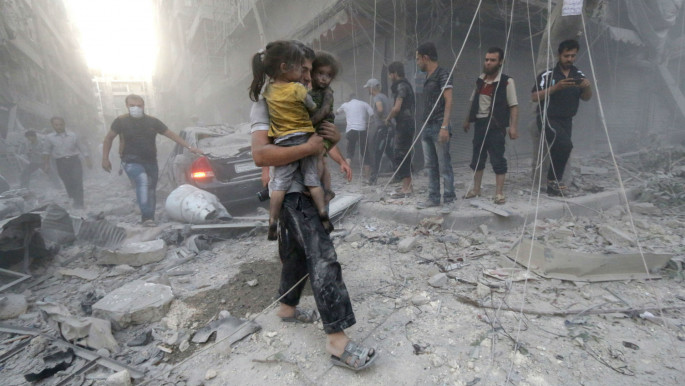Control of Syria's skies gives Assad the edge
Analysis: The Syrian regime has used air power to bombard rebels and civilian populations, and rebel groups can do little to stop it.
3 min read
Syria's opposition fighters are powerless against Assad's air power [AFP]
The Syrian regime's trump card in the civil war is its air power, which it uses to terrorise civilians with helicopter barrel bombs and attack rebel positions with its jet fighters.
Both sides know the strategic significance of the country's air bases. The regime began fortifying all bases under its control when the revolt of 2011 turned to civil war. The rebels, in turn, marked them as prime targets for takeover.
Opposition groups launched their first airbase attacks at the end of 2011, with an assault on Menagh, a base close to the Turkish border that would remain in regime hands until the summer of 2013.
Other rebel successes include the capture of Taftanaz, considered the largest helicopter base in Syria. However, cities such as Aleppo continue to be pounded by barrel bombs, dropped from regime helicopters.
The Islamic State group (IS, formerly known as Isis) captured Tabqa, 50km west of Raqqa, late last year. It was the last regime airbase in the province to fall.
Elsewhere, the Assad regime maintains a grip on many bases and landing strips. Hani al-Jaour, a former brigadier, listed its most-prized assets:
Tiyas: Also known as 'T4', near the ancient city of Palmyra, is the largest base in Syria. It has 54 concrete shelters and two 3km runways used by some of the regime's most advanced aircraft, such as the MiG-29 and Su-25. Tiyas is the launchpad for regime airstrikes on opposition positions, along with residential areas under rebel control.
Al-Dumayr airport: The second-largest military airbase in Syria after T4, located 40km north of Damascus. It contains 50 concrete shelters and two 3km runways.
Al-Sien airport: On the Damascus-Tadmor desert road, 80km from Damascus. It has 36 concrete shelters and two runways stretching for 3km and 2.5km. It is home to MiG-23, Mig-25 and Mig-27 jets, training aircraft and helicopters.
Jaour said that the probability of the opposition destroying the regime's air force remains slim, as the opposition has no effective anti-air firepower.
Many bases are located in desert areas far from the urban strongholds controlled by rebels. Rebels are also short of ammunition and weaponry, meaning a sustained assault would be nearly impossible.
Jaour added that opposition fighters had not effectively used those bases already under their control. The aircraft they control require parts and maintenance expertise the rebels lack. Any rebel jets that did make it into the air would face a regime force with overwhelming numbers, experience and an advanced air defence system.
The Syrian regime controls the skies, and it seems there is nothing the rebels can do to stop them.
This is an edited translation from our Arabic edition.
Both sides know the strategic significance of the country's air bases. The regime began fortifying all bases under its control when the revolt of 2011 turned to civil war. The rebels, in turn, marked them as prime targets for takeover.
Opposition groups launched their first airbase attacks at the end of 2011, with an assault on Menagh, a base close to the Turkish border that would remain in regime hands until the summer of 2013.
Other rebel successes include the capture of Taftanaz, considered the largest helicopter base in Syria. However, cities such as Aleppo continue to be pounded by barrel bombs, dropped from regime helicopters.
The Islamic State group (IS, formerly known as Isis) captured Tabqa, 50km west of Raqqa, late last year. It was the last regime airbase in the province to fall.
Elsewhere, the Assad regime maintains a grip on many bases and landing strips. Hani al-Jaour, a former brigadier, listed its most-prized assets:
 |
|
| Rebel-held towns such as Aleppo have been devastated by regime airstikes [AFP] |
Tiyas: Also known as 'T4', near the ancient city of Palmyra, is the largest base in Syria. It has 54 concrete shelters and two 3km runways used by some of the regime's most advanced aircraft, such as the MiG-29 and Su-25. Tiyas is the launchpad for regime airstrikes on opposition positions, along with residential areas under rebel control.
Al-Dumayr airport: The second-largest military airbase in Syria after T4, located 40km north of Damascus. It contains 50 concrete shelters and two 3km runways.
Al-Sien airport: On the Damascus-Tadmor desert road, 80km from Damascus. It has 36 concrete shelters and two runways stretching for 3km and 2.5km. It is home to MiG-23, Mig-25 and Mig-27 jets, training aircraft and helicopters.
Jaour said that the probability of the opposition destroying the regime's air force remains slim, as the opposition has no effective anti-air firepower.
Many bases are located in desert areas far from the urban strongholds controlled by rebels. Rebels are also short of ammunition and weaponry, meaning a sustained assault would be nearly impossible.
Jaour added that opposition fighters had not effectively used those bases already under their control. The aircraft they control require parts and maintenance expertise the rebels lack. Any rebel jets that did make it into the air would face a regime force with overwhelming numbers, experience and an advanced air defence system.
The Syrian regime controls the skies, and it seems there is nothing the rebels can do to stop them.
This is an edited translation from our Arabic edition.





 Follow the Middle East's top stories in English at The New Arab on Google News
Follow the Middle East's top stories in English at The New Arab on Google News


